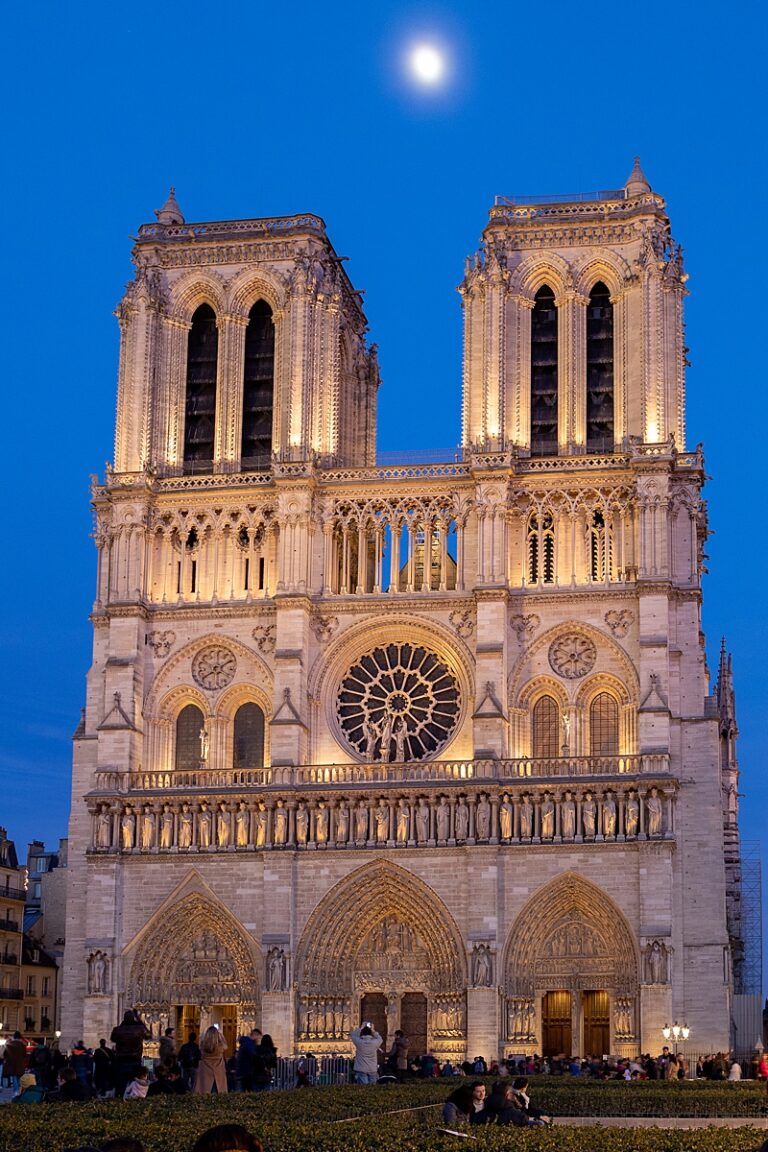Every time we return from a trip, it’s hard to imagine a trip being even better than the last one. Yet, here we are. I’m eager to share more about our experiences. I generally try to update previous posts with new information, so as we discover new wineries to visit in Italy, I tend to share them here.
One of the things that we have learned to truly enjoy is taking advantage of wine tastings in Italy. Italian winery tours are usually in-depth experiences, rather than just merely wine tastings. Through these visits to local wineries, we learn more about local food, wine, and often get to engage meaningful conversations with passionate individuals. I find these wine tours as informative as they are delicious.
One of the great things about Italy is that you don’t have to travel far to find good food and wine. I’m including some of my favorite tours from a handful of different regions to give you some ideas.
Disclosure: This post contains affiliate links for tours and products I love at no additional cost to you. You can read my full disclosure policy here.

Booking Wine Tastings in Italy
Unless you head to an enoteca (wine bar), wine tastings in Italy are quite a bit more formal than tastings in the US. While I know there are some areas in the United States where you can hop from winery to winery. In Italy, you generally need a reservation or an appointment. I’m a big fan of this system.
One, it allows everyone to prepare to spend the right amount of time with you. On every single one of these tours, we’ve been able to engage the winery staff in conversations about the wine, about the process, and about the area. We never feel rushed or that we are interrupting someone.
Second, it allows people to share their knowledge with you. When you go to an enoteca, the staff might not have the time to talk with you about what makes certain wines different. Is it the soil? The angle of the sun? The blend? It’s easier to have those conversations when you know someone is coming because you know they are coming for the knowledge.
Three, most wine tastings in Italy go beyond just tasting the wine. They often include a snack of some sort because of the long held tradition that alcohol should be served with food. In many cases, this has allowed us to try area specialties that we may or may not have ordered. In other cases, we’ve been able to have a full meal with a wine tasting, which teaches us more about how to correctly pair food and wine.
For these reasons, I try to book all of our wine tastings in advance. One of the ways I do that is by using Viator to identify wine tours in Italy close to where we are traveling. Viator’s robust offerings of food and wine tours has helped us find a lot of smaller wineries, rather than relying on the famous ones that are mass marketing in the United States. Visiting smaller wineries has been such a rich experience when traveling in Italy.
Italian Wine Classifications
We are not wine experts by any stretch of the imagination. We’re just two people who like to try regional products and learn as much as we can. If this is your first trip to Italy, I think it can be helpful to know more about how wine is classified. Let’s think about this like an inverted pyramid.

VdT – Vino da Tavola
These are your classic Italian table wines and they account for the largest wine production in Italy. There are no blend specifications for these wines, no limitations on the geographic area beyond merely being produced in Italy, and it provides opportunities for wineries to be creative.
IGT – Indicazione di Geografica Tipica
IGT wines encompass wines that are produced in a specific region of Italy but aren’t confined to specific production standards. One of the most famous examples of an IGT wine is a Super Tuscan, which is a great introductory wine to try. Most people find it quite “sessionable” (drinkable). IGT wines will have a label indicating it as such.
DOC – Denominazione di Origine Controllata
DOC wines include approximately 300 wines produced throughout Italy. These wines must adhere to certain regional production standards and protocols. DOC can also apply to other products that are produced regionally including cheese, olive oil, and balsamic vinegar. Like IGT wines, all DOC products will have a label indicating it as such.
DOCG – Denominazione di Origine Controllata e Garantita
There are approximately 50 DOCG wines currently produced in Italy. These wines must adhere to traditional recipes, as well as to specific aging and production processes. These wines are tested by an independent commission before they can be labeled as such. One of the most well-known DOCG wines is Brunello di Montalcino.

Tuscany Wine Tours
Tuscany is one of the most famous wine regions in Italy and rightly so. The Tuscan hill towns are some of the most famous because of how easily accessible they are by train or by car. I think it’s worth renting a car and staying in Tuscany if you’re up for it.
Most Tuscan wine is made of Sangiovese grapes. Before we started taking more wine tours, I always assumed that Sangiovese was almost exclusively used for red wines. Through our guides, however, I have learned that Sangiovese can be used to make some rose wines, as well as some white wines.
The number of grape varieties produced by private wineries varies significantly. We’ve visited wineries that produce 90% Sangiovese grapes, and we’ve visited wineries that produce Vernaccia, Chardonnay, Merlot, and a handful of other grapes.
The great thing about Tuscany is that you can find something for everyone at every price point. Don’t believe me? My mom, a stringent white wine drinker, has found Tuscan red and white wines that she enjoys… and it all started with a wine tasting in Italy!
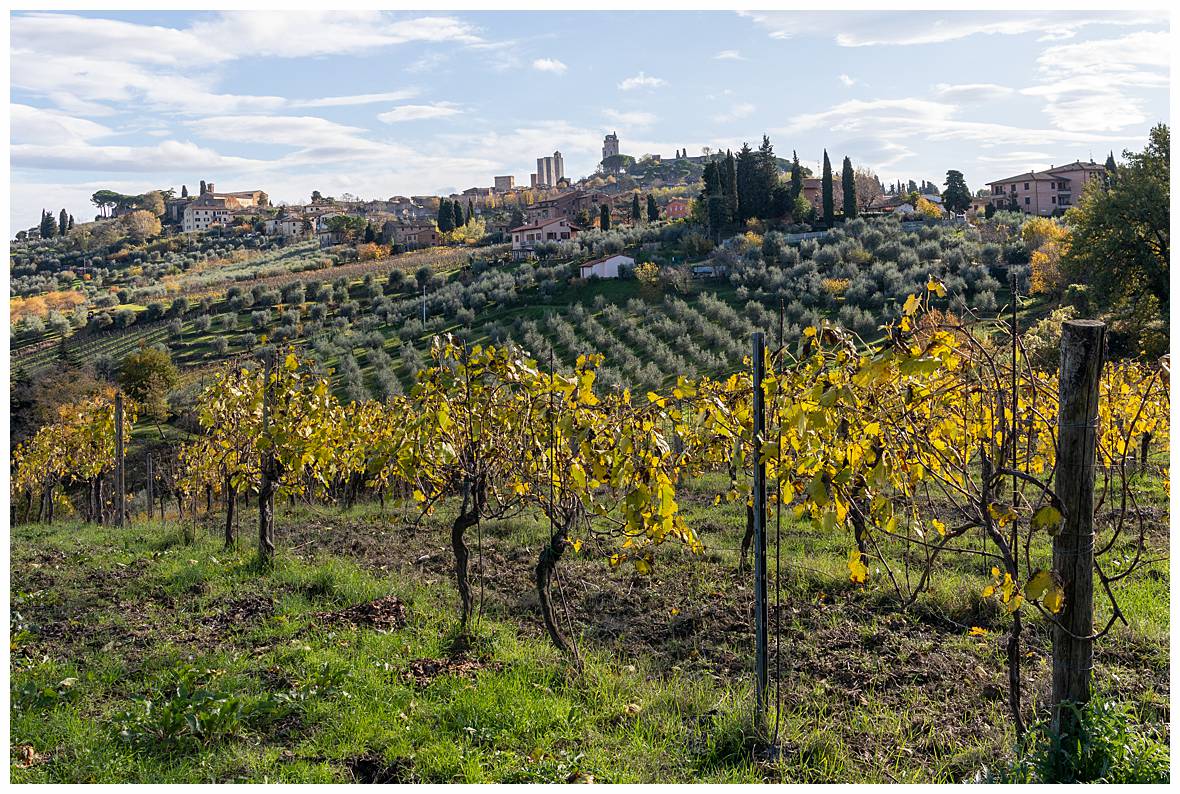
Chianti Classico Wine Tasting
DOCG Poggio Rosso Chianti Classico Gran Selezione (red wine)
DOCG Il Grigio Chianti Classico Gran Selezione (red wine, one of my favorites!)
DOCG Il Grigio Chianti Classico Riserva (red wine)
DOCG San Felice Chianti Classico (red wine)
DOCG Il Quercione Brunello di Montalcino (red wine)
DOCG Campogiovani Brunello di Montalcino (red wine)
DOC Campogiovani Rosso di Montalcino (red wine)
DOC Bell’aja Bolgheri Superiore (red wine)
DOC Bell’aja Bolgheri
On our 10th anniversary trip to Tuscany, we were on a wine tasting mission. On our first night, I ordered a bottle of San Felice Il Grigio Gran Selezione at one of our favorite restaurants in Florence, Cinghaile Bianco. My dear friend Kathleen had stayed at the resort in 2022 and brought several bottles home, so I trusted her recommendation. I’m not usually a Chianti Classico girl, but this wine caught me by surprise. Maybe it was the ambiance. Maybe it was the food. Maybe it was just that it was our first night in Italy, but it was lovely. A few nights later, we ordered the Il Grigio Riserva and enjoyed it as well.
Ultimately, we decided to make a trip to the San Felice winery to try more of their wines. We fell in love with the estate, and we can’t wait to go back and stay a few nights. Borgo San Felice is about an hour and a half south of Florence, not too far from Siena. It’s a Relais and Chateaux property, and I think it’s in one of the most beautiful areas of Chianti. Like many R&C properties, it is focused on sustainability and preserving local traditions, flavors, and culture.
The classic tour and wine tasting included a brief tour of the estate, a tour of the impressive cellar, and a tasting of 5 wines with local products. We had the opportunity to try the Chianti Classico, the Rosso and Brunello di Montalcino, and the Supertuscan wines. Ultimately, my favorite wine at the winery was the Bolgheri Superiore. The prices at the winery are much better than you will find elsewhere, and definitely better than they would be in the United States. Govern your wine suitcase accordingly.
BOOK: San Felice Wine Tasting




San Gimignano Wine Tour
DOCG Wine from San Gimignano: Vernaccia di San Gimignano (white wine).
DOCG Wine from San Gimignano: Chianti (red wine)
This San Gimignano wine tour is the first wine tasting in Italy we ever did. We love it so much that we’ve been back a few times over the years, and I regularly order wine from them. It’s a family-run winery that offers several wines to try at various prices points, including IGT and DOCG wines. A crowd favorite among our friends is the rose, but I’m a huge fan of their reds, specifically their DOCG Chianti. They have DOCG white wine available for purchase, and it’s one of my mom’s favorites.
The best way to experience this Tuscan winery is to book your wine tasting with lunch. They pair the wines with a traditional, fresh Italian meal and the flavors are just incredible. If you are traveling with people who aren’t into wine but still want to visit a winery, they also offer delicious olive oil tasting and truffle hunting options.
San Gimignano is only about an hour drive from Florence, so you could make it as a day trip. It’s also accessible by train and/or bus, though that takes a little bit longer. It’s also about 30 minutes to an hour from Siena, depending on your mode of transportation. The winery is a few minutes outside the city center of San Gimignano and offers gorgeous views of the town.
READ MORE: Olive Oil Tasting in Tuscany
READ MORE: San Gimignano Wine Tasting


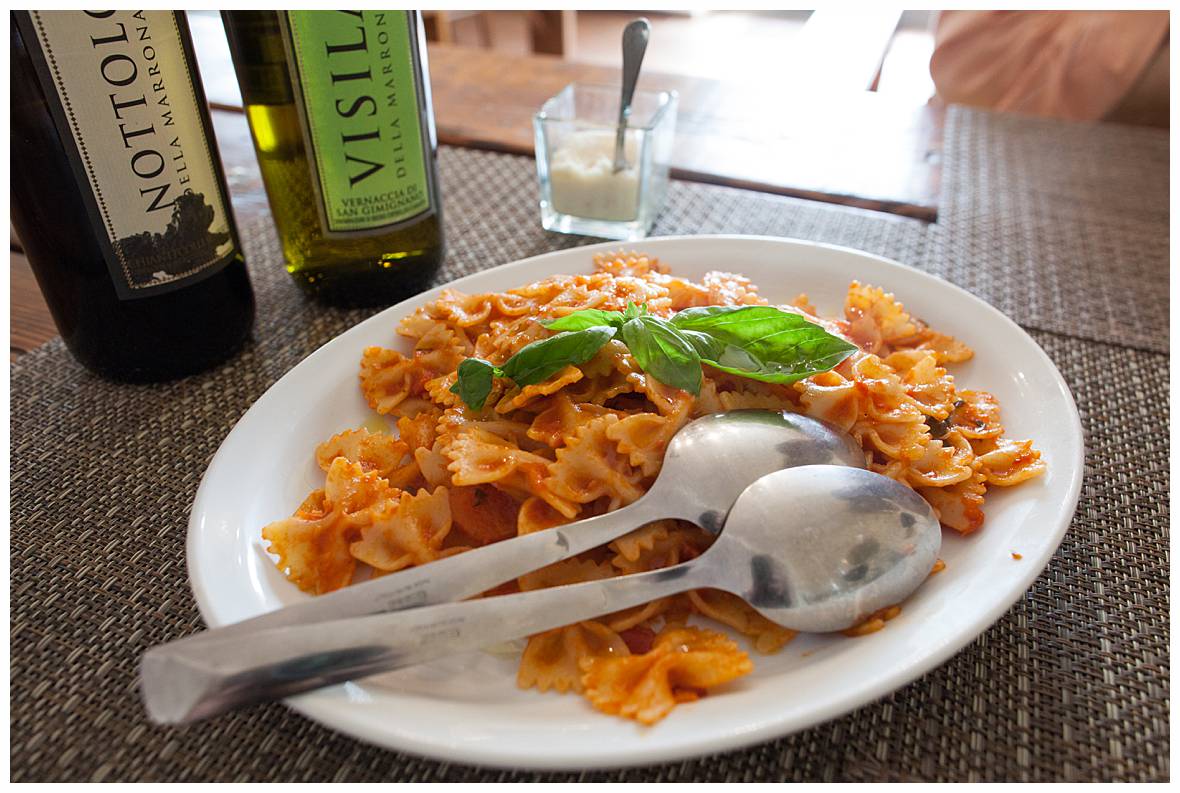

Arezzo Wine Tour
DOCG Wine from Arezzo: Chianti (red wine)
This Arezzo wine tasting was the first vineyard in Italy that we visited where we could see everything from the vineyards to the production facilities before the tasting. This organic winery is outside of Arezzo. Every part of the winery operates with sustainability in mind, and it is well-known for those practices. In fact, there were several university students studying wine production who took the tour with us specifically because of those practices. They sell organic wines, including two DOCG Chianti wines, as well as a few IGT wines.
After the tour of the vineyard and the production facilities, we headed to the gorgeous tasting room for instructions on how to properly taste wine. Again, we are not wine connoisseurs, so we enjoyed soaking up as much knowledge as we could. We were also able to taste the wines with bread, olive oil, local salami and cheese.
You’ll need a car to take advantage of this wine tasting. It’s about 20 minutes outside the city center of Arezzo.

Brunello di Montalcino Wine Tasting
DOCG Wine from Montalcino: Brunello di Montalcino (red wine)
I’m obsessed with the Rosewood Castiglion del Bosco resort. This is one of the most beautiful wineries in Italy. We stayed here twice in 2022, and once in early 2024. The resort and the cantina are both stunning. The wine library is just astonishingly beautiful. On both trips, we booked a Brunello di Montalcino wine tasting. The first one was a general tour of the winery and a tasting of the Brunello and Rosso di Montalcino wines (DOCG and IGT). The second tasting included a trip to the vineyard, and it was closer to a vertical tasting of the Brunello di Montalcino wines. You can book a wine tasting whether you stay at the resort or not, and I highly encourage you to do so!
The Castiglion del Bosco Brunello di Montalcino (DOCG) is one of my favorite Tuscan red wines. It pairs beautifully with meat, cheese, and makes a delicious apertivo. My only regret is that we didn’t buy more when we were there. Fortunately, I’ve found a few places that stock it in the United States, so I’m not totally stuck, but you have to keep an eye on which vintage of the Castiglion del Bosco Brunello di Montalcino is available!
When we go back, the wine suitcase will be used liberally!


Florence Wine Tasting Tour
While I think the Tuscany countryside is the best place for wine tasting, I also realize that not everyone is comfortable driving in Italy or wants to leave Florence when they are paying for an expensive hotel. Or, maybe you’re short on time and you don’t want to spend it driving. Whatever your reasoning, there are some great tours to taste Tuscan wines in Florence. We booked this Florence wine tour, which included numerous tastings throughout the city as well.
This Florence walking and wine tour starts off at enoteca in the Oltrarno neighborhood of Florence. At the enoteca, we were able to try a few red and white wines (including Chianti Classico), along with various traditional bruschetta options. Yes, liver pate was included. No, I am not a fan. As we made our way back across the Arno, we stopped at a few additional restaurants for food and wine. We were definitely feeling it by the end.
This tour is a great way to taste traditional Florentine and Tuscan food and wine while seeing different parts of the city. What I really loved is that we were able to visit restaurants and enotecas that were off the beaten path in Florence.
READ MORE: Best Florence Tours
READ MORE: 3 enotecas in Florence I love
Piedmont and Barolo Wine Tasting
One of the second most famous wine regions in Italy is the Barolo region in Piedmont. We were late arrivals to Barolo wines, and by late arrivals, I mean that we had a bottle during my birthday weekend in Florence in 2022, and fell in love with it. We started trying different Nebbiolo wines at home, but mostly struck out. Then, we started handing over wine selection to the sommelier at Le George in Paris, and we found some amazing Nebbiolo wines. We scheduled and cancelled a trip to Piedmont at least three times, but we finally made in 2024! There are 19 DOCG wines in Piedmont, so it’s definitely one of the places to head for high end wines. Here are just a few of Piedmont wines we tried over the course of a few days:
DOCG Barbaresco (red)
DOCG Barbera d’Asti (red)
DOCG Barbera del Monferrato Superiore (red)
DOCG Barolo (red)
DOCG Cortese di Gavi, also simply called Gavi (white)
DOCG Nizza (red)
DOCG Roero, and Roero Arneis (white)
Piedmont Wine Tasting
We stayed at Palas Cerequio, a wine resort located in the heart of the Piedmont and Barolo region. Cerequio refers to a single vineyard that is used to produce Barolo wines. Gabriele, our sommelier, was incredible. One of the things that is unique about Palas Cerequio is that they sell and offer tastings from other Barolo producers. This should tell you a lot about the confidence they have in their wines. Since we didn’t know much about Piedmont wines beyond Barolo, we started our stay with the Michele Chiarlo wine tasting. This tasting included the Gavi di Gavi Rovereto (white), Nizza Cipressi (red), Barbaresco Reyna (red), Barolo Tortoniano (red), and Barolo Cerequio (red). All of the wines were fantastic. The biggest surprise for me was the Gavi, which I ordered as an apertivo at dinner that night. (I regret not buying some to bring home!) However, I also loved the Nizza, and all of the Barolos we tried. We tried the 2020 Barolo Tortoiano at the tasting, but ordered the 2019 at dinner. The 2019 was incredible.

Barolo Vertical Tastings
Once we had spent a little more time with the Nebbiolo grape, we were excited to try a couple of vertical wine tastings of Barolo. Again, we returned to Gabriele at Palas Cerequio for wine tasting. As I mentioned above, Cerequio is a single vineyard used to produce Barolo, and it’s the vineyard that the wine resort over looks. The Cerequio vertical introduced us to Voerzio Martini Cerequio 2019, Damilano Cerequio 2019, Vietti Cerequio 2019, Boroli Cerequio 2019, and Chiarlo Cerequio 2019. It was incredible to see the various expressions of the wine, all of which originate from the same vineyard. While they were all lovely, my favorites from this tasting were the Boroli and the Chairlo.
After learning that we truly enjoyed the Michele Chiarlo wines, Gabriele recommended that we do a vertical Barolo tasting of the Cerequio wines. We were able to try 2013 Cerequio Riserva, as well as the 2013, 2015, 2017, and 2019. Ultimately, and unsurprisingly, I loved the 2013 Riserva, but we also found the 2019 to be lovely. It seems that 2019 is going to be a lovely vintage not only for Brunello di Montalcino, but also for Barolo as well.
Veneto Wine Tasting (Valpolicella and Amarone)
DOCG Wine from Veneto: Soave Superiore (red wine)
DOCG Wine from Veneto: Amarone della Valpolicella (red wine)
DOCG Wine from Veneto: Bardolino Superiore (red wine)
If you can squeeze in a few extra extra nights in your Venice itinerary, I recommend staying in a wine resort in the Veneto to try these famous wines. Villa Cordevigo is a great place to taste a variety of Valpolicella wines from the Veneto! They offer three different options for wine tastings that include both wineries that the property owns and operates, Vigneti Villabella and Villa Cordevigo.
After our first night at Villa Cordevigo, we booked the La Nostra Terra tasting with Paolo, which allowed us to try a variety of white and red wines. We tried a traditional Chardonnay (DOC), Bianco Veronese (IGT), Rosso Veronese (IGT), Bardolino Chiaretto (DOC), Bardolino Classico 50th Anniversary (DOC), and a Bianco Passito (IGT). I LOVED the Passito and regret not bringing more home with us. Tom loved the Bardolino 50. We kept a bottle to open on New Year’s Eve 2022 in Florence.
We enjoyed our wine tastings so much that we asked Paolo to guide us through another tasting. We did a custom tasting with the Valpolicella Ripasso (DOC), Soave Classico (DOC), Lagana (DOC), along with some special wines, Aristeo, Oseleta, and Guadenzia. Several of these are “house” blends that are unique to these vineyards, so if you are looking for something special, this is a great option.
The La Rossa tasting includes a Montemazzano (IGT), Villa Cordevigo Rosso (Igt), Amarone della Valpolicella (DOC), and Bardolino Classico (DOC). These reds are vineyard specific red wines, as well as some of the regional specific wines. I loved the Amarone and ordered it with dinner every night.
We visited in the winter, so we didn’t have the opportunity to tour the vineyards with a guide, but I would like to return and enjoy the grape to glass experience and see the vineyards in bloom. You do not have to stay at Villa Cordevigo to schedule a wine tasting, but you do have to book in advance. Paolo’s knowledge, experience, and passion are contagious, so I definitely recommend adding this area to your Italy itinerary.
Villa Cordevigo is 30 minutes from Verona (by car), 1.5 hours from Bologna by car, and 2 hours from Venice (by car).


Wine Tasting in Verona
If you can’t make it to Villa Cordevigo for a wine tasting or you want to try additional wines from the Veneto, I highly recommend booking a wine tasting in Verona with Bruno, a sommelier who owns a small wine shop in the old city center of Verona. Located just a few blocks away from the Arena, Bruno’s shop has tons of wines from small producers in the Veneto, and a small assortment of wines from other regions of Italy. Bruno’s knowledge and enthusiasm for wine is contagious, and he was excited to introduce us to wines we had not tried, as well as some unique producers of some of the famous Veneto wines. We tried one white wine, three red wines, and a dessert wine. Bruno’s tasting helped us better navigate the wine lists throughout our entire trip to Verona, and I’m excited to see how it helps us as we continue to explore the Veneto.
One of the things that made this wine tasting unique is that Bruno showed us now the flavor profile of wines changed with what we ate. I think he is the first person who has really shown (not just told) us the importance of pairing wine and food. I am still trying to figure out how to do that at home, but it was illuminating to see how getting the pairing wrong can really change your perception of a wine.
Wine Tasting in Venice
While the wines and prosecco of the Veneto are famous in their own right, I find it hard to recommend paying for a hotel in Venice and taking a full day trip to the countryside. That said, if you’re going to be in Venice and want to try local wines, I have the perfect option for you. This Venice wine tasting takes place on a canal-side wine bar in one of the quieter neighborhoods of Venice. With its tiny tables and cozy décor, I wish we had booked this for our honeymoon in Venice! It’s the perfect activity for a romantic weekend in Venice.
This wine tasting offers a myriad of wines from the region (including some Croatian wines), as well as wines from various other Italy wineries. If you aren’t sure what to try, the bar owner is happy to make recommendations. In our case (3 people), he served us an entire rainbow of wines to try. It was delicious and gorgeous. The wines were served with some delicious seasonable vegetables, as well as fresh salami and cheese.
When my mom asked where she could purchase one of the sparkling wines, the owner offered to sell directly to her since he wasn’t sure where she would be able to find them. He also helped us track down where to locally purchase some of the cheese he served. This was an absolutely unexpectedly lovely experience away from the crowds of Venice, and I can’t recommend booking this wine tasting in Venice enough.



Umbria Wine Tours
The first time I stayed at Borgo dei Conti in 2019, I fell in love with a few Umbrian hill towns. Granted, it was Christmastime, so things might have felt a little extra magical, but when we went back in June 2021, they didn’t disappoint.
While Tuscans and Umbrians may compete with who is more authentic or more Italy, I find them both to be great to visit in their own right. I think that Umbria is one of Italy’s most underrated food and wine destinations. The food and wine we had on our last trip to Umbria was absolutely outstanding. The landscape and views can be more riveting than Tuscany in some cases. That is probably because I’m from Texas and I’m not used to seeing such verdant hills. That said, Umbria isn’t called the green heart of Italy for nothing! We’ve done quite a few wine tasting tours in Umbria now, and all of them have been very special experiences
A lot of the cities aren’t quite as busy as the more popular towns in Tuscany, so you can have meals with locals, watch children play in the town center, and feel like you’re in a living community. It’s not to say that those things don’t happen in Tuscany – they do. I, however, do enjoy the slower pace of Umbria sometimes. I honestly think that you should visit both, if for no other reason than the wine. The wine in Umbria is delicious, and there are several cases that will be making their way to Dallas this summer.
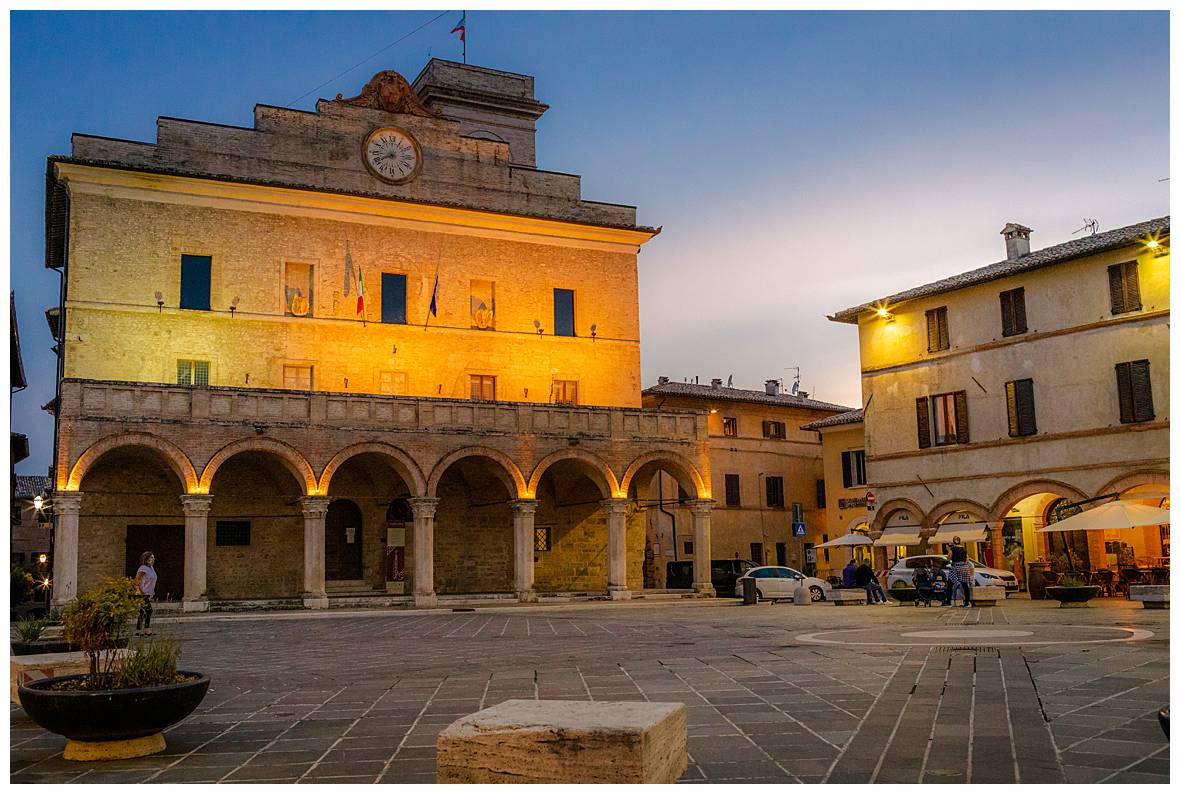
Montefalco Wine Tasting
DOC Wine from Montefalco: Trebbiano Spoletino (white wine)
DOC Wine from Montefalco: Montefalco Rosso (red wine)
DOC Wine from Montefalco: Montefalco Sagrantino Passito (red wine)
DOCG Wine from Montefalco: Montefalco Sagrantino (red wine)
Borgo dei Conti introduced us to Montefalco wine and encouraged us to visit to try more. When you visit Umbria, Montefalco should be on the top of your list. Beyond that, this Montefalco wine tasting should be at the top of your list of things to do in Umbria. I think we’ve done this wine tasting 3 or 4 times, and we’ve stopped to pick up wine multiple times.
The views from the Bocale vineyard are absolutely outstanding and seem to stretch on for miles. It is bit outside the town center, so I recommend having a car to visit some of the smaller towns in Umbria. It is run by a pair of brothers, who decided to resuscitate the family vineyard in the not-so-distant past. One of the owners, Valentino, knows a lot about the area and can provide some awesome recommendations. He is an incredible host with stories from traveling around the world to see his wine. He also taught us about the classifications of wine (and other delicious products) in Italy.
This Montefalco vineyard produces a couple of traditional Umbrian red and white wines including Montefalco Sagrantino, Montefalco Rosso, Montefalco Trebbiano Spoletino, and my new favorite, Montefalco Sagrantino Passito.
I was particularly excited when I found these wines on the menu at a couple of restaurants we visited in Norcia, another incredible town in Umbria. While I always want to add more towns to my list, I know that we will definitely be back in Montefalco.



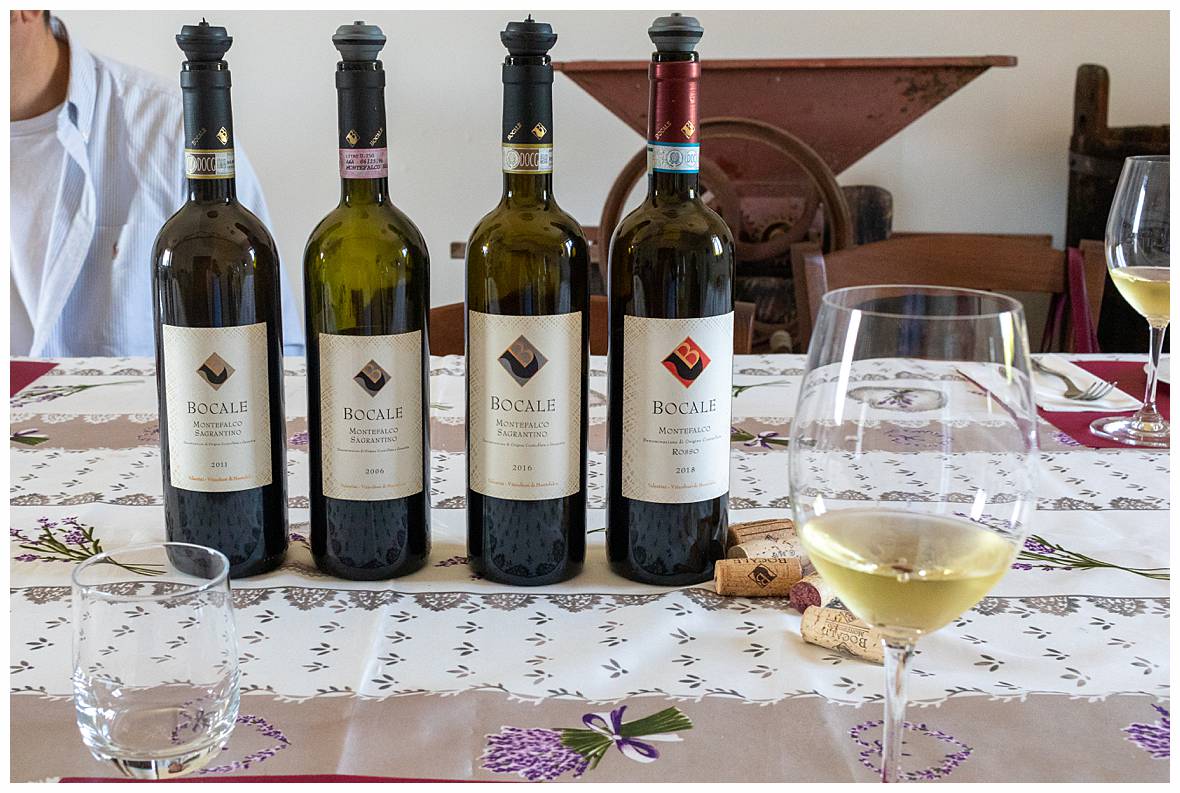
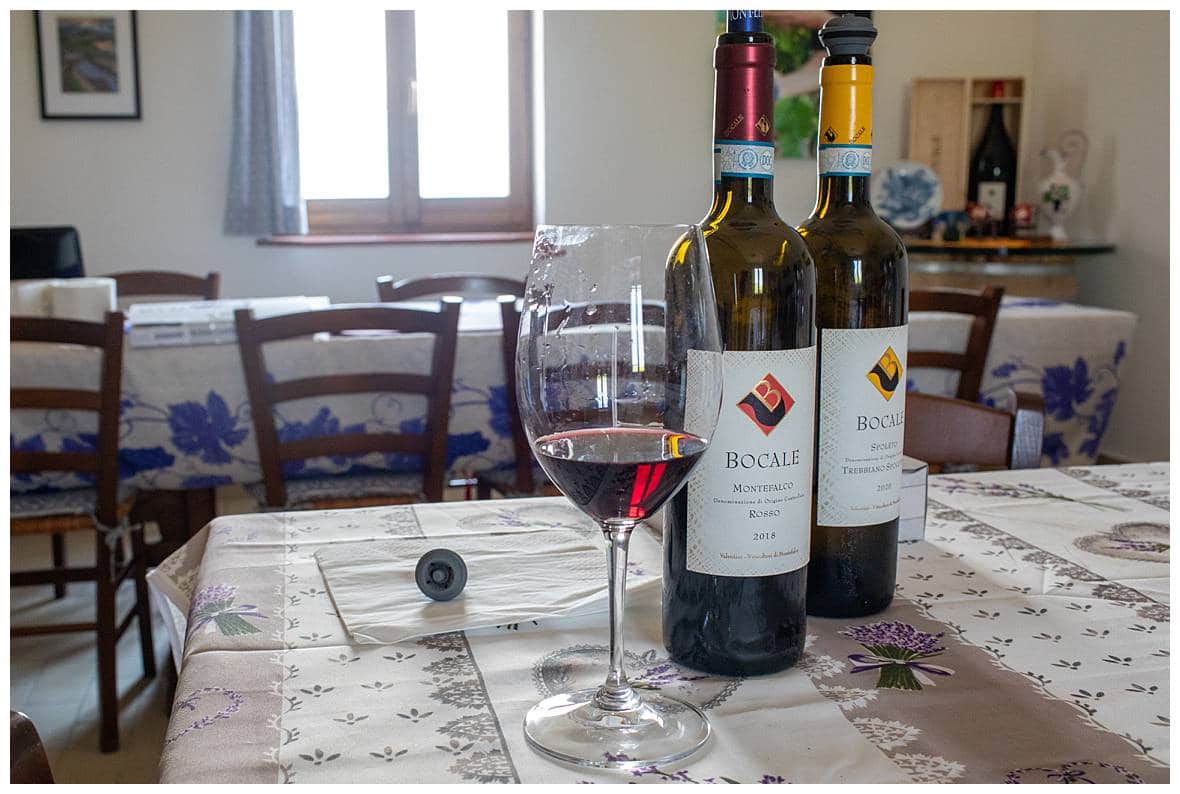

Assisi Wine Tasting
If I had to choose the best place to do wine tasting in Italy with a view, this Assisi winery would be it. This family-run winery is located a short drive outside of Assisi (they offer pick up options), and it’s certainly worth the trip, if not just for the view.
This Umbrian olive oil and wine tasting starts with a visit to the vineyard and olive groves. We learned a lot about the shape of olive trees, the care of them, and received a more in-depth education on the production of olive oil. From there, we headed back to a table overlooking the view for a formal tasting.
Before starting, we were provided instruction on the proper way to taste olive oil (which we had learned a little bit about this on our road trip through Croatia). One thing that made this tour unique is that they had us try a cheaper mass-produced olive oil before tasting the real thing. I highly recommend this if you’re a novice.
After we tried the olive oil, we moved on to the wine tasting. We were also treated to some delicious bruschetta, Umbrian meats and cheeses, a delicious fresh pasta and vegetable dish, and even a bit of dessert wine.
While everything was delicious, what really made this tour memorable was the conversations with the family. We were hosted by a mother and daughter whose witty banter kept us laughing. Though we kept our social distance from other groups, we were able to engage in some wonderful conversations with a few students traveling through the region as well. I can’t help but think that these human connections are why we all travel in the first place.
READ MORE: Things to Do in Assisi
READ MORE: Two Nights in Assisi

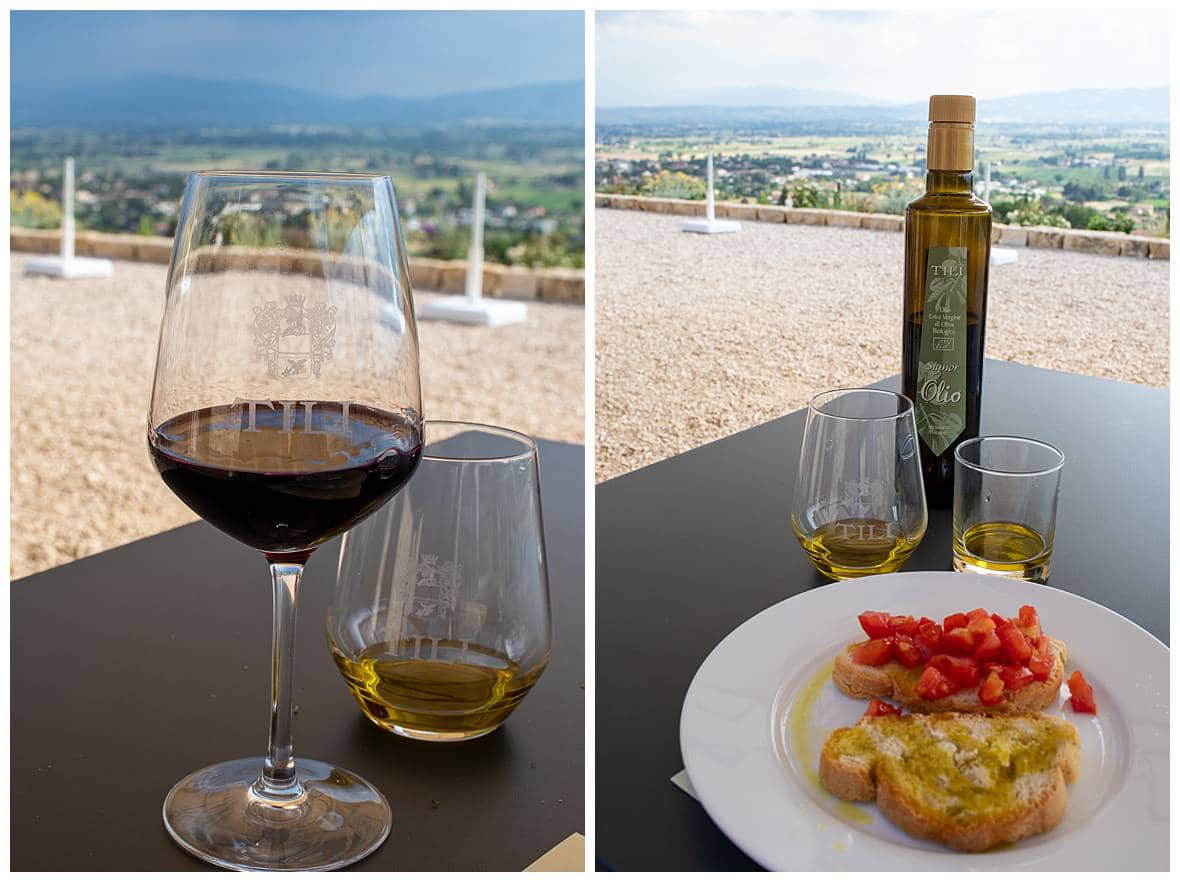
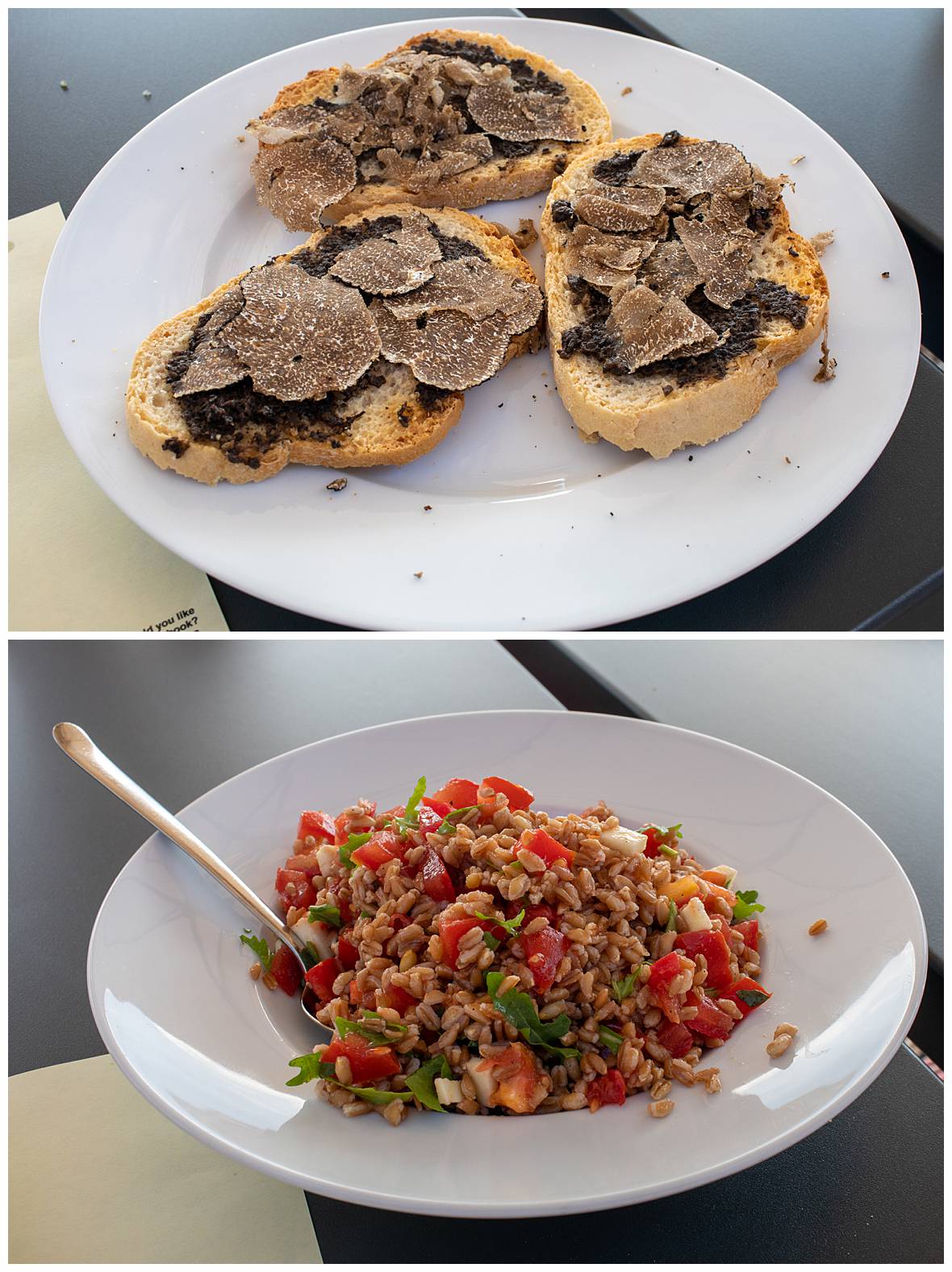


Todi Wine Tasting
DOCG Wine from Umbria: Montefalco Sagrantino (red wine)
DOC Wine from Umbria: Montefalco Rosso (red wine)
In September 2021, I was attending a conference in Seattle and I ended up driving down to Olympia to see one of my friends from college. We had dinner at Swing Wine Bar (10/10 recommend) and I tried an Umbrian wine that was on special. It was a Melagrano from Cantina Roccafiore. A few weeks later, Tom and I were on a long weekend trip to Cortona and I decided to see what I could find out about Roccafiore. We ended up booking a wine tasting a tour of the facility. Eduardo provided us insight into the different ways they produce their blends, and also shared more about some of the more “experimental” things they are trying to get back to ancient production techniques. Overall, I found it to be a very interesting tour.
The sleek design of the Roccafiore facility is a sharp contrast with the beautiful rolling hills of Umbria. The tasting room functions as both an art gallery and a wine tasting room. The large windows give you a beautiful view of the countryside. We ended up trying 5 wines in total – 2 white wines and 3 red wines. We ended up bringing 12 bottles home – the fiorfiore, the melagrano rosso, and the Prova D’Autore. What I liked about the Roccafiore wines is that they were different than the other Umbrian wines we’ve tried. I’m really looking forward to curling up with the Prova on a cold winter evening.
After the tour, we wandered around the vineyard a bit. It’s in a very peaceful area with beautiful views all around. Roccafiore is a wine resort in Umbria, which we were eager to book after our lovely experience at the Meneghetti in Istria. We stayed at the Roccafiore hotel and spa in January 2022 and had a lovely, relaxing stay.

Casale Wine Tasting
IGT Wine from Montefalco: Macchieto Umbria Rosso, the “Super Umbrian” (red wine)
DOC Wine from Montefalco: Trebbiano Spoletino (white wine)
DOC Wine from Montefalco: Trebbiano Spoletino Superiore (white wine)
DOC Wine from Montefalco: Montefalco Rosso (red wine)
DOC Wine from Montefalco: Montefalco Sagrantino Passito (red wine)
DOCG Wine from Montefalco: Montefalco Sagrantino (red wine)
Cantina Cimate Wine: Muller Thurgau Passito (sweet white wine)
Cantina Cimate Wine: Aragon Vermentino (white wine)
In April 2022, we were enjoying apertivo at Borgo dei Conti when we were introduced to Le Cimate’s Trebbiano Spoletino. We knew we liked the varietal because of our visits to Bocale in Umbria and it didn’t steer us wrong. We enjoyed quite a few bottles throughout our stay, and before heading back to the US, we stopped by the winery to pick up a few bottles to take home. (That might have been the trip we brought home 39 bottles of wine. I can’t remember.) We went through them quickly last summer. Trebbiano Spoletino is a delightful summer wine.
In October, we scheduled an official tasting as we made our way from FCO to Cortona for a long weekend. We were able to tour the facilities with the winemaker and see the beginning of the fermentation process, which was really cool. The winemaker remembered us from our earlier visit, so he was excited for us to try more of his wines. Our tasting including traditional Umbrian products, including sausages, cheeses, breads, and olive oil. The pairings were exceptional. We brought home a variety of wines, but the Macchieto stands out to me as one of my favorite red wines from Cimate. We also brought home more of both Trebbiano Spoletinos, as well as a couple bottles of the white passito. This was a really nice wine tasting experience because we got to try so many interesting varietals beyond the DOC and DOCG wines.
The area around Cimate is really lovely. You will need a car to get there. Last time we were there, they mentioned that they are building an apartment on site that you might be able to stay at. It’s high on Tom’s list of places he wants to stay because he’s enjoyed our Cimate experiences so much.





Cinque Terre Wine Tour

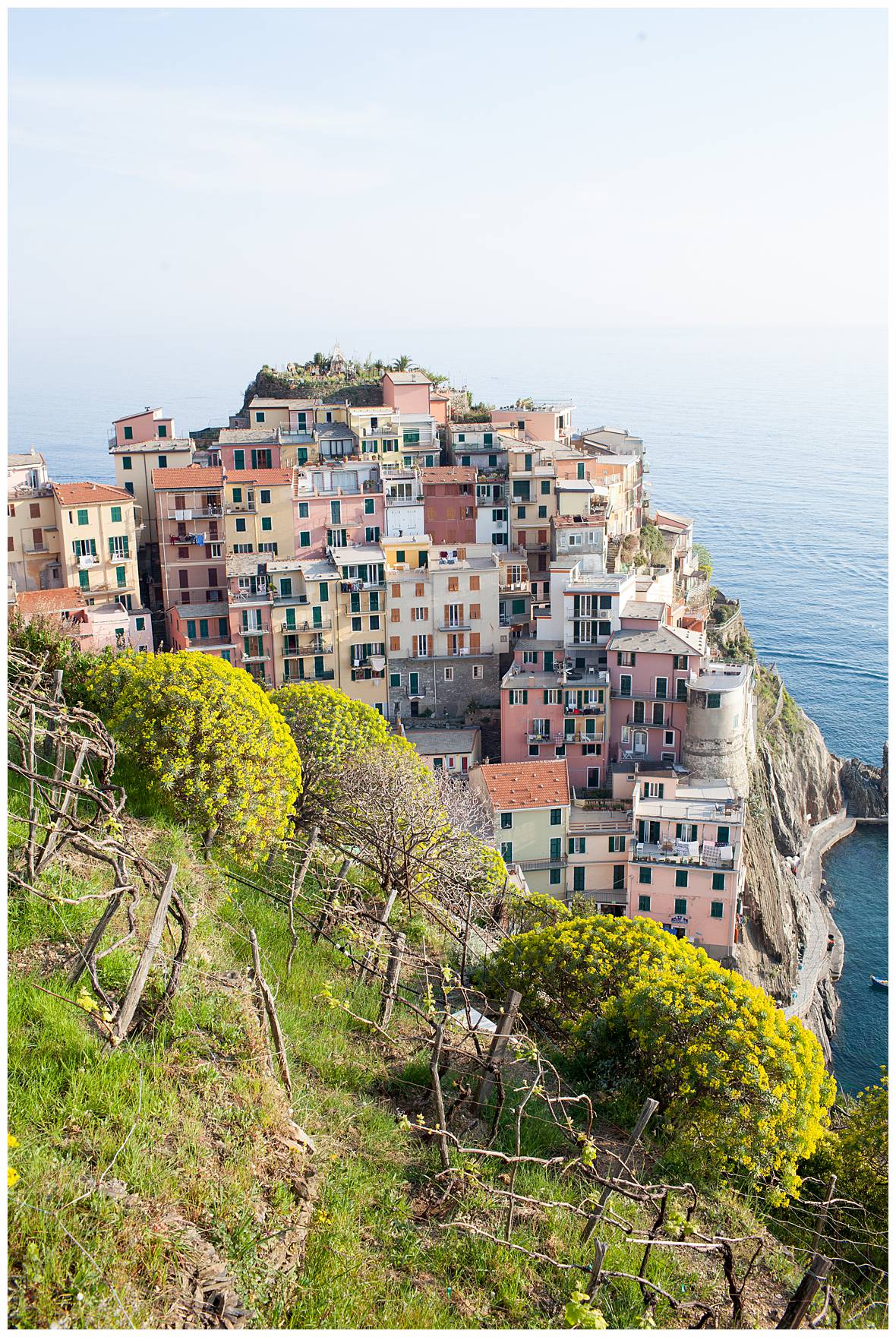
One thing that we didn’t expect to become so enamored by is the wine terraces of Cinque Terre. We knew the area produced its own wine, but we didn’t expect that the terrain would be so drastic. It’s really quite a marvel to see how Italy is about to cultivate its landscape so well.
On our second trip to Cinque Terre, we booked a tour and tasting for the famous Cinque Terre Sciacchetra wine. Sciacchetra is a white wine that is only produced in the Cinque Terre region and I think it’s definitely something you should try in Cinque Terre.
What I loved about our Cinque Terre wine tour is that it introduced us to the vineyards by way of a walk around the wine terraces of Manarola. This provided us numerous vantage points that we probably would not have explored and helped us understand the challenges of the terrain. After taking in the views, we headed into a local wine production facility to taste the sciacchetra.
Our guide, a Manarola native, was able to talk to us about the challenges of tourism, the population decline in the Cinque Terre, and why it’s so important to come and stay in Cinque Terre. While we’ve never treated it like a day trip – always choosing to spend at least two nights – it was sobering to hear more about how the culture of day trippers has significantly affected the community and local economy. This tour is a great way to engage with so many aspects of the culture of Cinque Terre, which makes it a valuable way to spend time.
READ MORE: Wine Tasting in Cinque Terre


